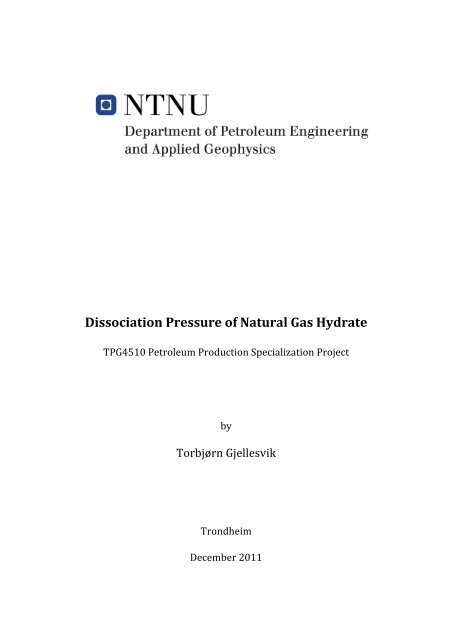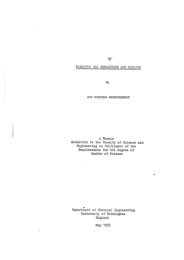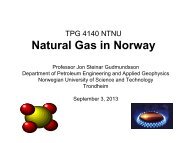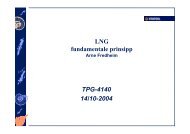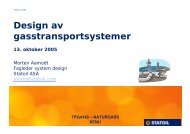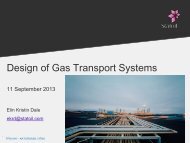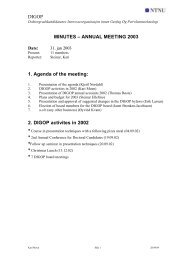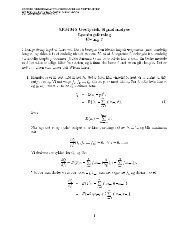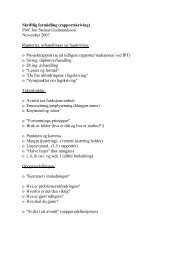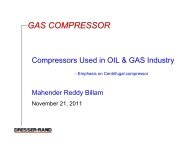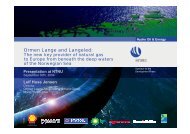Dissociation Pressure of Natural Gas Hydrate - NTNU
Dissociation Pressure of Natural Gas Hydrate - NTNU
Dissociation Pressure of Natural Gas Hydrate - NTNU
Create successful ePaper yourself
Turn your PDF publications into a flip-book with our unique Google optimized e-Paper software.
<strong>Dissociation</strong> <strong>Pressure</strong> <strong>of</strong> <strong>Natural</strong> <strong>Gas</strong> <strong>Hydrate</strong> <br />
TPG4510 Petroleum Production Specialization Project <br />
by <br />
Torbjørn Gjellesvik <br />
Trondheim <br />
December 2011
Acknowledgements <br />
This project could not have been completed had it not been for the help and input <strong>of</strong> <br />
others. I have encountered issues both where I have been in doubt regarding what to do <br />
and how to do it. Without the help <strong>of</strong> these people I would probably have struggled <br />
immensely to complete the project in time. <br />
First, I would like to thank Pr<strong>of</strong>essor Jon Steinar Gudmundsson for all his help in finding <br />
a suitable problem description and guidance along the way. Many <strong>of</strong> the resources I have <br />
used could not have been accessed without his help and some are crucial to the final <br />
result <strong>of</strong> this work. I would also like to thank for quick responses to any questions I <br />
might have had and good advice. <br />
Second, I would like to thank my fellow students, especially within petroleum <br />
production, for their input, thoughts and suggestions. The communication I have had <br />
with them has been motivational and a great help throughout the semester.<br />
<br />
ii
Abstract <br />
The dissociation pressure and temperature <strong>of</strong> natural gas determines when hydrate <br />
formation can take place. Initial formation <strong>of</strong> hydrate takes place at slightly higher <br />
pressures and lower temperatures due to a small amount <strong>of</strong> energy required for the first <br />
crystallization. The dissociation pressure is very valuable in planning steps to mitigate <br />
hydrate formation in oil and gas production. <br />
Several methods exist for calculating the dissociation pressure <strong>of</strong> natural gas hydrate, <br />
ranging from rigorous computer methods to simpler hand calculation methods. In this <br />
project, a comparison between computer models and hand calculation methods has <br />
been performed. Aspen HYSYS has been used as an example <strong>of</strong> available computer <br />
methods, whereas the correlation presented by Østergaard et al. (2000) and an updated <br />
version <strong>of</strong> the Makogon correlation (1981) has been selected as hand calculation <br />
methods. The ground for comparison is made by assuming HYSYS to be a reference <br />
point and investigating how well the hand calculation models correspond under <br />
different circumstances when applied to three typical mixtures <strong>of</strong> natural gas. <br />
Also, the effect <strong>of</strong> certain parameters on the dissociation pressure has been investigated, <br />
as well as a brief overview <strong>of</strong> currently used inhibitors in the industry. By varying the <br />
contents <strong>of</strong> N2, CO2 and H2S the results have been presented graphically. <br />
Results show that the Makogon correlation corresponds surprisingly well with results <br />
from HYSYS in many situations. The effects <strong>of</strong> N2 and CO2 have been identified by the <br />
Østergaard et al. correlation. Calculations performed by increasing H2S content also <br />
shows that it has a severe negative effect on the dissociation pressure <strong>of</strong> natural gas <br />
hydrate. <br />
<br />
iii
Table <strong>of</strong> Contents <br />
ACKNOWLEDGEMENTS.................................................................................................................................II <br />
ABSTRACT.......................................................................................................................................................III <br />
TABLE OF CONTENTS.................................................................................................................................. IV <br />
LIST OF TABLES ..............................................................................................................................................V <br />
LIST OF FIGURES.............................................................................................................................................V <br />
INTRODUCTION ..............................................................................................................................................1 <br />
PROJECT DESCRIPTION...................................................................................................................................................... 1 <br />
NATURAL GAS..................................................................................................................................................3 <br />
PROPERTIES......................................................................................................................................................................... 3 <br />
ECONOMIC AND ENVIRONMENTAL IMPORTANCE......................................................................................................... 4 <br />
NATURAL GAS HYDRATES...........................................................................................................................6 <br />
PROPERTIES......................................................................................................................................................................... 6 <br />
NATURAL OCCURRENCE.................................................................................................................................................... 7 <br />
HYDRATE INHIBITION........................................................................................................................................................ 8 <br />
CHEMICAL POTENTIAL ...................................................................................................................................................... 8 <br />
THE HAMMERSCHMIDT EQUATION................................................................................................................................. 9 <br />
DISSOCIATION PRESSURE ........................................................................................................................ 10 <br />
INFLUENCING PARAMETERS.......................................................................................................................................... 10 <br />
FIELDS AND GAS COMPOSITIONS........................................................................................................... 12 <br />
SHTOKMAN ....................................................................................................................................................................... 12 <br />
ORMEN LANGE ................................................................................................................................................................. 13 <br />
GENERIC ............................................................................................................................................................................ 14 <br />
CALCULATION METHODS ......................................................................................................................... 15 <br />
HYSYS............................................................................................................................................................................... 15 <br />
DERIVATION OF THE PENG-‐ROBINSON EQUATION OF STATE................................................................................. 16 <br />
MAKOGON, ELGIBALY & ELKAMEL............................................................................................................................... 18 <br />
THE BAILLE-‐WICHERT METHOD ................................................................................................................................. 21 <br />
RESULTS ......................................................................................................................................................... 22 <br />
MODEL COMPARISONS.................................................................................................................................................... 22 <br />
EFFECT OF H 2S AND MODEL APPLICABILITY .............................................................................................................. 24 <br />
DISCUSSION ................................................................................................................................................... 28 <br />
CONCLUSION ................................................................................................................................................. 32 <br />
REFERENCES ................................................................................................................................................. 33 <br />
APPENDIX A................................................................................................................................................... 36 <br />
MODEL COMPARISONS.................................................................................................................................................... 36 <br />
ØSTERGAARD ET AL. CORRECTION FOR N 2 AND CO 2 ................................................................................................ 37 <br />
EFFECT OF H 2S – HYSYS............................................................................................................................................... 38 <br />
EFFECT OF H 2S – ØSTERGAARD ET AL. ....................................................................................................................... 39 <br />
EFFECT OF H 2S – MAKOGON ET AL.............................................................................................................................. 40 <br />
<br />
iv
List <strong>of</strong> Tables <br />
Table 1: <br />
Table 2: <br />
Table 3: <br />
Table 4: <br />
Table 5: <br />
Coefficients for the Hammerschmidt equation, Ci. <br />
Ci-‐constants used in the Østergaard et al. correlation. <br />
α-‐constants used in the Østergaard et al. correlation. <br />
Field compositions. <br />
Inhibitor base price. <br />
List <strong>of</strong> Figures <br />
Figure 1: Overview <strong>of</strong> the biggest gas producing countries. <br />
Figure 2: Estimated future consumption <strong>of</strong> energy sources. <br />
Figure 3: Model comparison – Ormen Lange <br />
Figure 4: N2 and CO2 correction using the Østergaard et al. correlation -‐ Shtokman <br />
Figure 5: Effect <strong>of</strong> H2S content. HYSYS results – Ormen Lange <br />
Figure 6: Effect <strong>of</strong> H2S content. Makogon et al. – Ormen Lange <br />
Figure 7: Effect <strong>of</strong> H2S content. Østergaard et al. – Ormen Lange <br />
Figure 8: Inhibitor vapor pressures. <br />
Figure A1: Model Comparison -‐ Shtokman <br />
Figure A2: Model Comparison -‐ Generic <br />
Figure A3: Model Comparison – Ormen Lange <br />
Figure A4: Østergaard <strong>Dissociation</strong> Curves – Shtokman <br />
Figure A5: Østergaard <strong>Dissociation</strong> Curves – Ormen Lange <br />
Figure A6: HYSYS Effect <strong>of</strong> H2S -‐ Shtokman <br />
Figure A7: HYSYS Effect <strong>of</strong> H2S -‐ Generic <br />
Figure A8: HYSYS Effect <strong>of</strong> H2S – Ormen Lange <br />
Figure A9: Østergaard et al. Effect <strong>of</strong> H2S -‐ Shtokman <br />
Figure A10: Østergaard et al. Effect <strong>of</strong> H2S -‐ Generic <br />
Figure A11: Østergaard et al. Effect <strong>of</strong> H2S – Ormen Lange <br />
Figure A12: Makogon et al. Effect <strong>of</strong> H2S -‐ Shtokman <br />
Figure A13: Makogon et al. Effect <strong>of</strong> H2S – Generic <br />
Figure A14: Makogon et al. Effect <strong>of</strong> H2S – Ormen Lange <br />
<br />
v
Introduction <br />
<strong>Natural</strong> gas has a great upside for future applications. Faced with a growing worldwide <br />
demand for energy, while at the same time also faced with the issues <strong>of</strong> global warming, <br />
the consumption <strong>of</strong> natural gas is expected to grow in the future. The simple answer is <br />
because <strong>of</strong> two things: First, the worldwide reserves <strong>of</strong> natural gas exceed hose <strong>of</strong> crude <br />
oil by approximately 10%. Second, burning <strong>of</strong> natural gas as a source <strong>of</strong> energy emits <br />
less CO2 than alternate fossil fuels by 20-‐40% per unit <strong>of</strong> energy consumed, making it <br />
more environmentally friendly (IEA, 2011). Therefore, as a substitute for coal and crude <br />
oil, natural gas represents a significant contribution in reducing climate gas emissions to <br />
the atmosphere. As governments strive to reduce emissions by as much as possible, it is <br />
easy to understand why the natural gas consumption is expected to grow. <br />
The aim <strong>of</strong> this project is first and foremost to try and answer the questions put forward <br />
in the problem description. As the title aptly describes, the subject <strong>of</strong> the project is the <br />
dissociation pressure <strong>of</strong> natural gas hydrate. <strong>Hydrate</strong>s are solids that are commonly <br />
encountered in the transportation <strong>of</strong> natural gas. They are very unfavorable as they can <br />
do severe damage to pipelines and equipment, and they are very hard to avoid because <br />
hydrate formation conditions <strong>of</strong>ten lie within the operating region <strong>of</strong> oil and gas <br />
production. <br />
Project Description <br />
“Oil and gas cannot be produced through <strong>of</strong>fshore pipelines without the prevention <strong>of</strong> <br />
hydrate formation. <strong>Hydrate</strong> forms due to high pressure and low temperature, typically 100 <br />
bara and 20°C. The exact hydrate formation point depends on the composition <strong>of</strong> the fluids <br />
involved; gas composition and water/brine composition. <br />
Computer and analytical methods have been developed to predict the dissociation pressure <br />
<strong>of</strong> natural gas hydrate. The dissociation pressure can be used to determine how much <br />
antifreeze needs to be added to prevent the formation <strong>of</strong> hydrate. The purpose <strong>of</strong> the <br />
present project is to investigate how the various parameters affect the dissociation <br />
pressure <strong>of</strong> hydrate, including gas composition, presence <strong>of</strong> acid gases and the salt content <br />
<strong>of</strong> the liquid water phase. The HYSYS code can be used and an attempt should be made to <br />
find out what theoretical method is used there. Available analytical methods should be <br />
<br />
1
used and compared to the results from HYSYS. Try to answer the question whether a <br />
mixture <strong>of</strong> antifreeze chemicals <strong>of</strong>fers any advantage in preventing the formation <strong>of</strong> <br />
hydrate” (Gudmundsson, 2011). <br />
The dissociation pressure is the required pressure for hydrates to start dissolving. For <br />
that reason, it is very valuable information to have in order to plan for avoidance and <br />
inhibition <strong>of</strong> hydrates. Not only does the dissociation pressure provide information <br />
about what it takes to dissolve already formed hydrates, but in reversing the point <strong>of</strong> <br />
view, it also determines the conditions where hydrates continue to form. Conditions for <br />
initial hydrate formation tends to be at lower temperatures and pressures than the <br />
dissociation pressure. This is because a small amount <strong>of</strong> energy is required for the first <br />
hydrate to crystallize. As soon as hydrate has formed, the dissociation pressure <br />
determines the continued formation. This clarifies why knowledge about the conditions <br />
for dissolving already formed deposits is important in order to avoid them in the first <br />
place. <br />
<br />
2
<strong>Natural</strong> <strong>Gas</strong> <br />
Properties <br />
To understand the concept <strong>of</strong> natural gas hydrates, one needs to have an idea <strong>of</strong> what <br />
natural gas really is and its application. This way, it is much easier to comprehend the <br />
safety, technical and economical challenges that hydrate formation represents in the <br />
petroleum industry. <br />
<strong>Natural</strong> gas occurs naturally and is <strong>of</strong>ten associated with production <strong>of</strong> crude oil. It is <br />
created through decomposition <strong>of</strong> organic material under high pressures and <br />
temperatures. Furthermore, fuel is its biggest application, whether as fuel for means <strong>of</strong> <br />
transportation or as a source <strong>of</strong> electricity for domestic heating and other appliances. <br />
The main components are the light hydrocarbon components: Methane (CH4), ethane <br />
(C2H6), propane (C3H6), n-‐ and i-‐butanes (C4H10) and n-‐ and i-‐pentanes (C5H12). Other <br />
heavier hydrocarbon components are also present in typical natural gasses, but they are <br />
not typical and <strong>of</strong>ten not in significant amounts. Non-‐hydrocarbon components <strong>of</strong>ten <br />
present in natural gas include nitrogen (N2), carbon dioxide (CO2) and hydrogen sulfide <br />
(H2S) (Carroll, 2003). Moreover, natural gas is usually saturated with water vapor, and <br />
this is when the hydrate warning signs start flashing. Water is a requirement for <br />
hydrates to from and is further explained in the next section, which describes the <br />
properties <strong>of</strong> natural gas hydrate. <br />
A typical natural gas is significantly richer in methane than the other components. <br />
Methane content <strong>of</strong>ten lies in the region <strong>of</strong> 90%, depending on its origin. Non-‐associated <br />
gas, which is gas normally present in the reservoir, tends to have higher methane <br />
content (90+%) than associated gas. Associated gas has vaporized, or flashed, out <strong>of</strong> <br />
solution from crude oil. This gas tends to have less than 90% methane content <br />
(Gudmundsson, 2011). According to the amount <strong>of</strong> methane, the ethane content in <br />
natural gas lies around 0-‐10%, propane from 0-‐5%, while the heavier components <br />
gradually decrease further. Non-‐hydrocarbon components tend to amount to 0-‐5% <strong>of</strong> <br />
the gas, with H2S content possibly reaching as high as 15%. Obviously, natural gas <br />
encompasses a very wide variety <strong>of</strong> compositions and it might be easier to look at it as <br />
gas produced for fuel and power generation purposes. <br />
<br />
3
With fuel being the number one application <strong>of</strong> natural gas, the non-‐hydrocarbon gasses <br />
are considered unfavorable. They do not have any heating value, rendering them useless <br />
as fuels (Carroll, 2003). They are also rarely considered very valuable to other ends, <br />
although there are some exceptions. CO2 can, assuming the appropriate infrastructure, <br />
be re-‐injected and used as means to build pressure in reservoir. H2S also serves some <br />
purpose in the manufacturing <strong>of</strong> artificial fertilizer or sulfur, but its value is very <br />
dependant on demand (www.snl.no, 2003). <br />
Economic and Environmental Importance <br />
The present estimated reserves <strong>of</strong> natural gas exceed those <strong>of</strong> crude oil by <br />
approximately 10%, in terms <strong>of</strong> energy content. The vast majority <strong>of</strong> reserves come from <br />
Russia, Iran and Qatar and amount to over half <strong>of</strong> the total world reserves. Norway’s gas <br />
reserves are about 4% <strong>of</strong> the total world reserves. The price <strong>of</strong> natural gas is calculated <br />
from energy content, not by volume. The most common unit is dollars per million British <br />
thermal units ($/MMBtu). One British thermal unit is the amount <strong>of</strong> energy required to <br />
heat one pound <strong>of</strong> liquid water from 60 F to 61 F under atmospheric pressure (1 atm) <br />
(www.snl.no, 2011). <br />
Figure 1: Overview <strong>of</strong> the biggest gas producing countries. <br />
The natural gas price is somewhat less volatile than that <strong>of</strong> crude oil. This is because the <br />
production is easier to regulate, making it more adaptable to current demand. However, <br />
it tends to follow the same trends as the oil price. <br />
<br />
4
There are several advantages with using gas compared to other fossil fuels, so there’s a <br />
significant upside to future applications. The perhaps biggest positive <strong>of</strong> natural gas is <br />
that it emits less CO2 than other fuels. When compared to coal and oil, natural gas emits <br />
40% and 20% less CO2 per unit <strong>of</strong> energy used. In power generation, modern gas <br />
turbines produce about half <strong>of</strong> what current coal-‐fired plants do (IEA World Energy <br />
Outlook, 2011). <br />
Transportation <strong>of</strong> gas is easier and much more efficient in terms <strong>of</strong> volumes across <br />
distance. However, the present infrastructure needs to be improved in order to reach <br />
more people. Governments are constantly trying to find more environmentally friendly <br />
and sustainable sources <strong>of</strong> energy. Germany is a good example. By 2022, they’ve moved <br />
to decommission all <strong>of</strong> their nuclear power plants, although the grounds for the decision <br />
are from a safety perspective. The consequences <strong>of</strong> nuclear power generation became <br />
painfully obvious in 1986 by the Tschernobyl meltdown, and more recently by the <br />
Fukushima incident in Japan, January 2011, which is said to spark Germany’s sudden act <br />
towards decommission. Due to the many advantages over other fossil fuels, natural gas <br />
is a commodity expected to be consumed more and more in the future (See Fig. X). In <br />
order to reach EU’ goal <strong>of</strong> reducing total CO2 emissions by 20% by the year 2020, the use <br />
<strong>of</strong> certain fossil fuels has to decrease. Moving away from coal and crude oil, natural gas <br />
is a great substitute, reducing emissions quite substantially and being easier to <br />
transport. <br />
An interesting trend is that national gas consumption seems to follow the GPD <strong>of</strong> said <br />
nation one-‐to-‐one. Hence, for a 1% increase in GDP there’s also a 1% increase in gas <br />
consumption. Especially for the BRIC-‐countries (Brazil, Russia, India and China), the <br />
population is becoming increasingly rich, leading more people to afford higher living <br />
standards. Higher energy consumption follows as a direct result and the demand <br />
increases. As long as the proper infrastructure is in place, gas can be an extremely <br />
valuable resource to countries in rapid growth as large supplies will be readily available <br />
at a low cost. Therefore, the IEA assumes that out <strong>of</strong> the currently available energy <br />
sources, gas consumption will increase the most in the years to come (IEA World Energy <br />
Outlook 2011). <br />
<br />
5
Figure 2: Estimated future consumption <strong>of</strong> energy sources. <br />
<strong>Natural</strong> <strong>Gas</strong> <strong>Hydrate</strong>s <br />
Properties <br />
A hydrate is a compound that resembles ice and consists <strong>of</strong> water and a second <br />
substance. This second substance can be a lot <strong>of</strong> things, but in natural gas hydrate, they <br />
are the light hydrocarbon components methane, ethane, propane and butane, and non-hydrocarbons<br />
such as CO2 and H2S. <strong>Hydrate</strong> made up <strong>of</strong> these components and that <br />
forms in natural gas is the focus <strong>of</strong> this project. <strong>Hydrate</strong> is not ice, but has a very similar <br />
physical appearance. Whereas ice is crystalline frozen water that only occurs at <br />
temperatures <strong>of</strong> 0°C or less (assuming atmospheric pressure), hydrates occur at <br />
temperatures above the freezing point <strong>of</strong> water and at very high pressures (0-‐25°C and <br />
≈100 bara). They also require the presence <strong>of</strong> these second substances, or host <br />
molecules, to form. The host molecules are smaller than the water molecules and small <br />
enough to fit inside crystalline structures formed by the water molecules. (The cages <br />
that are typical to hydrates are <strong>of</strong>ten referred to as “clathrates”. The word “clathrate” <br />
comes from the Latin “clathratus”, meaning “lattice bars”.) <br />
When the temperature and pressure conditions favor the formation <strong>of</strong> hydrate the water <br />
molecules start aligning in a certain pattern. The host molecule stabilizes the already <br />
organized water molecules and is what causes them to crystallize. The crystals <br />
<br />
6
effectively form a cage, held together by hydrogen bonding, trapping the host molecules. <br />
A hydrogen bond is the attractive intermolecular force between the polar water <br />
molecules. The two positively charged hydrogen atoms <strong>of</strong> a water molecule attract the <br />
negative oxygen atoms from other molecules, forming an intermolecular bond. In a <br />
pipeline, as soon as a hydrate crystal is formed, they will continue to travel along with <br />
the flow. This isn’t as problematic, so long as the crystals are small. Obviously, larger <br />
crystals can damage pipeline equipment such as valves and pumps and needs to be <br />
accounted for. Irregularities and equipment installed within the pipeline make good <br />
nucleation points and cause the hydrates to deposit (Gudmundsson, 2011). <br />
“Good nucleation sites for hydrate formation include an imperfection in the pipeline, a <br />
weld spot, or a pipeline fitting (elbow, tee, valve, etc.) Silt, scale, dirt and sand all make <br />
good nucleation sites as well” (Carroll, 2003). <br />
After nucleation is when the hydrate issues start to become major. Once hydrates have <br />
deposited and the conditions still favor continued formation, the deposits grow like a <br />
rolling ball <strong>of</strong> snow. This is very problematic as the deposits become large. Ultimately, it <br />
may lead to reduced pipe flow (due to reduced cross-‐sectional flow area), damaged <br />
equipment and possibly plugged pipelines. Thus, issues caused by hydrates represent a <br />
safety hazard and <strong>of</strong>ten require costly and time-‐consuming maintenance operations. <br />
<strong>Natural</strong> Occurrence <br />
A peculiar fact about natural gas hydrates is that they actually pose as a potential source <br />
<strong>of</strong> energy. They occur naturally where the pressure and temperature conditions are <br />
right, <strong>of</strong>ten below sea level, but also onshore in permafrost regions. The crystal <br />
structure <strong>of</strong> hydrates traps the host molecules within a cage. There is no connection <br />
between the water molecules and the trapped host molecule, sparking the thought <strong>of</strong> <br />
extracting the hydrocarbon components from within their hydrate cages. <strong>Natural</strong>ly <br />
occurring hydrates as a source <strong>of</strong> fossil fuel has still not prevailed as a sustainable <br />
source <strong>of</strong> energy. This is because <strong>of</strong> the environmental and geological effects <strong>of</strong> <br />
extracting these hydrates. Methane, which is the most common hydrocarbon found in <br />
hydrates is a powerful greenhouse gas and would have a severe effect on the <br />
environment. Removal <strong>of</strong> the naturally occurring hydrates is also hazardous because it <br />
<br />
7
affects the geological stability and could lead to subsea landslides etc. (Kvenvolden, <br />
1993). <br />
<strong>Hydrate</strong> Inhibition <br />
A lot <strong>of</strong> resources are spent towards predicting and preventing hydrate formation in the <br />
petroleum industry. Pipelines are commonly insulated over short distances to avoid <br />
severe temperature drops. Over longer pipeline intervals, large amounts <strong>of</strong> chemical <br />
inhibitors are injected to alter the thermodynamic properties <strong>of</strong> the fluid flow, causing <br />
the hydrate forming conditions to lie outside <strong>of</strong> the operating conditions. Obviously, to <br />
be able to safely predict the hydrate formation <strong>of</strong>fers many advantages. <br />
Chemical Potential <br />
The change in chemical potential (µ) over the course <strong>of</strong> the chemical reaction <strong>of</strong> hydrate <br />
formation is very interesting as it introduces a measure towards hydrate inhibition. A <br />
simple reaction for hydrate formation can be described as follows: <br />
H 2<br />
O( l) + <strong>Gas</strong> ↔ H 2<br />
O( hyd) <br />
Changing the reaction with respect to chemical potential and expressing it algebraically <br />
gives: <br />
Δµ = µ hyd<br />
H2 O<br />
l<br />
− µ H2 O<br />
− µ gas <br />
where µ hyd H20, µ l H20 and µgas is the chemical potential <strong>of</strong> hydrate, liquid water and gas, <br />
respectively. The chemical potential can be explained as the measure <strong>of</strong> a substance’s <br />
contribution to the function’s rate <strong>of</strong> change (Baierlein, 2001). The above reaction will <br />
only happen as long as Δµ < 0. However, the chemical potential <strong>of</strong> gas and hydrate <br />
cannot be changed, thus the chemical potential <strong>of</strong> liquid water is the only thing that can <br />
be altered. The expression for the chemical potential <strong>of</strong> water can be described as: <br />
l<br />
µ H2 O<br />
<br />
= µ H2 O<br />
<br />
+ RT ln( a H2 O ) = µ H2 O<br />
+ RT ln( γ x H2 O H 2 O ) <br />
where µ°H2O is the standard Gibbs free energy, <strong>of</strong>ten expressed as G°(T), R is the <br />
universal gas constant (8,314 J/K·mol), T is temperature (K), a is the activity <strong>of</strong> the <br />
substance, γ is specific gravity and x the molar fraction <strong>of</strong> water. Remembering that the <br />
<br />
8
eaction only goes if Δµ < 0, by reducing the mole fraction <strong>of</strong> water the chemical reaction <br />
will shift to the left and thereby prevent hydrate formation. This introduces water <br />
dilution as a means <strong>of</strong> hydrate inhibition, which is described (Sandengen, 2011 & <br />
Skogestad, 2009). <br />
Commonly used inhibitors in the petroleum industry today include: Methanol, ethanol, <br />
monoethylene glycol (MEG), diethylene glycol (DEG) and triethylene glycol (TEG). In <br />
fact, salt may also be used as an inhibitor as it too lowers the hydrate formation <br />
temperature. Temperature depression is the common denominator for all the chemical <br />
inhibitors. Unfortunately, injection <strong>of</strong> chemical inhibitors is not very effective, at least <br />
not economically speaking. Large quantities are <strong>of</strong>ten required causing the economics <strong>of</strong> <br />
inhibition to be considered. <br />
The Hammerschmidt Equation <br />
There exist simple methods to figure out the quantity <strong>of</strong> chemical inhibitor needed in <br />
order to obtain a certain temperature depression. The Hammerschmidt equation is a <br />
widely used example <strong>of</strong> such a method. A prerequisite for the equation is to have <br />
information about the hydrate dissociation for the given mixture <strong>of</strong> fluid. This is because <br />
the Hammerschmidt equation only computes the temperature depression by injecting a <br />
certain amount <strong>of</strong> inhibitor. Assuming knowledge about the hydrate dissociation <br />
conditions, the equation is used to determine the quantity <strong>of</strong> inhibitor needed. The <br />
Hammerschmidt equation: <br />
ΔT =<br />
M i<br />
C i<br />
W i<br />
( )<br />
100 − W i<br />
where ΔT is the temperature depression caused by the inhibitor, Ci is a constant <br />
depending on type <strong>of</strong> inhibitor (see Table 1), Mi is the molecular weight <strong>of</strong> the inhibitor <br />
and Wi is the weight fraction <strong>of</strong> inhibitor. Turning the equation around, the <br />
Hammerschmidt equation becomes: <br />
W i<br />
=<br />
100M i ΔT<br />
C i<br />
+ M i<br />
ΔT ( )<br />
Hence, as long as the required temperature depression is known, the weight fraction or <br />
inhibitor can easily be obtained. <br />
<br />
9
Table 1: Coefficients for the Hammerschmidt equation, Ci. <br />
<strong>Dissociation</strong> <strong>Pressure</strong> <br />
The dissociation pressure <strong>of</strong> natural gas hydrate is the pressure at which the hydrates <br />
first start to dissolve. Knowledge about when hydrates dissolve is used to predict when <br />
hydrates can be expected to form. This is somewhat <strong>of</strong> an oxymoron but still the most <br />
accurate way <strong>of</strong> identifying when the actual formation starts. In order for hydrates to <br />
form, the natural gas mixture needs to be supersaturated with water, meaning it <br />
contains more water vapor than actually possible to solve in the gas mixture. This is the <br />
most important condition needed for continued formation. However, if no hydrates are <br />
already present in the mixture, the conditions need to favor nucleation or crystallization. <br />
This generally means additional cooling, as hydrate forms at low temperatures. <br />
If no hydrates have crystallized at the initial conditions, the first record <strong>of</strong> hydrates <br />
would occur under the nucleation or crystallization conditions. Under these conditions, <br />
the temperature would be lower than what is required for already formed hydrate <br />
deposits to grow (Gudmundsson, 2011). So, consider the case where hydrates are <br />
already present. <strong>Dissociation</strong> will only happen as soon as the natural gas mixture is <br />
undersaturated with water. The temperature at which the hydrates start to dissolve is in <br />
fact the first point where hydrates can safely be expected. <br />
Influencing Parameters <br />
There are many parameters that affect the specific dissociation pressures and <br />
temperatures. Especially gas composition, and thereby gas gravity, influences <br />
temperatures and pressures needed to dissolve natural gas hydrate. For the <br />
<br />
10
hydrocarbon hydrate formers, the lighter the component, the higher the dissociation <br />
pressure tends to be. Of the non-‐hydrocarbon formers commonly present in natural gas, <br />
N2 exhibits a higher dissociation pressure than CO2 and H2S, respectively (Carroll, 2003). <br />
Both CO2 and H2S are Type 1 hydrate formers and regarded as acid components. N2 is a <br />
Type 2 former and an inert component, meaning it is chemically inactive. Therefore, <br />
increasing the amount <strong>of</strong> acid components causes the mixture to contain more hydrate <br />
formers, thus increasing the potential for hydrate formation. Conversely, high contents <br />
<strong>of</strong> non-‐hydrate formers will make the mixture less prone to hydrate formation. The fact <br />
that the non-‐formers in natural gas tend to be the heavier hydrocarbons further reduce <br />
the possibility <strong>of</strong> hydrate formation because <strong>of</strong> their tendency to liquefy at typical <br />
hydrate forming conditions for natural gas. Although liquid components do not <br />
theoretically exclude the possibility <strong>of</strong> hydrates forming (liquid phase hydrate formation <br />
is entirely plausible), the conditions for such hydrates to form are different from than <br />
the conditions for gas hydrates. <br />
Salinity has also shown to influence the dissociation temperature <strong>of</strong> hydrates. For pure <br />
water, salinity will stretch the temperature scale in both ends, meaning it will freeze at <br />
lower temperatures than usual, and boil at temperatures higher than usual. In the paper <br />
presented by Mohammadi & Richon (2007), a similar approach to the problem is used to <br />
investigate the effects <strong>of</strong> salinity on the hydrate dissociation temperature, and thus, <br />
dissociation pressure. <br />
Salt lowers the hydrate formation temperature and following correlation applies for <br />
saline water temperature correction: <br />
T = T 0<br />
− 2,65ΔT b <br />
T is the hydrate dissociation temperature, T0 is the dissociation temperature for distilled <br />
water and ∆Tb is the boiling point elevation <strong>of</strong> the aqueous solution for distilled water <br />
under atmospheric pressure. The authors <strong>of</strong> the paper also recommend the Østergaard <br />
et al. correlation, which is described later, as a suitable way <strong>of</strong> obtaining the dissociation <br />
temperature in the presence <strong>of</strong> distilled water (Mohammadi & Richon, 2007). Due to <br />
lack <strong>of</strong> data on boiling point elevations due to salinity, the effect <strong>of</strong> salinity is simply <br />
described in this project without case examples or simulations <strong>of</strong> any kind. <br />
<br />
11
Fields and <strong>Gas</strong> Compositions <br />
Shtokman <br />
The Shtokman Field is a significant gas field by world comparison and lies on the <br />
Russian Arctic Shelf 555 km northeast <strong>of</strong> Murmansk. Its reserves are estimated to be <br />
somewhere in the region <strong>of</strong> 3,8 trillion cubic meters and about 53,4 million tons <strong>of</strong> gas <br />
condensate. The field is actually somewhat larger (3,9 trillion cubic meters gas and 56 <br />
million tons <strong>of</strong> condensate), but by reserves it is referred to the volumes Gazprom, <br />
which is the field operator, can reach within the area they have a license. <br />
Gazprom owns the license to operate the Shtokman field through one <strong>of</strong> its subsidiaries. <br />
The project <strong>of</strong> developing and operating the field is divided into three phases. In Phase 1, <br />
other companies also take part in the field development. Gazprom, Total E&P and Statoil <br />
(formerly StatoilHydro) are stakeholders in Shtokman Development AG, which is the <br />
company in charge <strong>of</strong> developing Phase 1 <strong>of</strong> the Shtokman field. Gazprom, Total E&P and <br />
Statoil hold 51%, 25% and 24% <strong>of</strong> the stakes in the company, respectively. <br />
Phase 1 encompasses all the preparations from drilling to production, and the initial <br />
field development. As <strong>of</strong> the first quarter <strong>of</strong> 2011, the two required drilling rigs are <br />
completed. A total <strong>of</strong> six subsea templates, each with four well slots, have already been <br />
planned for. <br />
The Shtokman field will be operated utilizing floating production units (FPSOs/FPUs). <br />
The FPUs are connected to the subsea templates via flexible risers. The produced <br />
volumes are processed aboard the FPUs before they are sent back to the seafloor and <br />
into pipelines. The pipelines will carry the gas and condensate onshore over the vast <br />
distance <strong>of</strong> 555 km to the planned gas treatment unit (GTU) in Zavalishina bay in <br />
northwestern Russia (Gazprom, 2011). <br />
<br />
12
Ormen Lange <br />
Ormen Lange is the second largest gas field in Norway, only beaten by the Troll field, and <br />
the third largest in Europe. It is located <strong>of</strong>fshore in the Møre basin about 120 km <br />
northwest <strong>of</strong> Kristiansund in the southern part <strong>of</strong> the Norwegian Sea. It can be classified <br />
as a deepwater field as the water depths lie between 800 – 1100 meters. The field was <br />
discovered in 1997, and put in production on the 13 th <strong>of</strong> September 2007. Fairly new <br />
technology is used in the production <strong>of</strong> the field. As <strong>of</strong> October 27 2011, there are 16 <br />
producing wells currently in operation connected to 3 subsea templates. Planned <br />
development <strong>of</strong> the Ormen Lange field accounts suggests that a total <strong>of</strong> 24 producing <br />
wells are to be drilled. This number is subject to change as the field is developed (Norske <br />
Shell, 2011). <br />
Norske Shell is the field operator but a number <strong>of</strong> entities are licensees in the field. <br />
These include Shell (17%), ExxonMobil (7%), DONG (10%), Statoil (29%), Petoro (37%) <br />
(NPD, 2011). <br />
The reservoir itself lies in the “Egga” formation and consists <strong>of</strong> Paleocene sandstone at <br />
depths <strong>of</strong> 2700 – 2900 meters subsurface. The produced gas is transported across the <br />
120 km from wellhead to shore in two multiphase subsea pipelines. The conditions are <br />
rather extreme with sub-‐zero water temperatures at seabed (Norske Shell, 2011). <br />
Hence, hydrate formation is very plausible and relevant to the successful operation <strong>of</strong> <br />
this field. <br />
<br />
13
Generic <br />
The third composition I’ve chosen to include in my work is a fictional natural gas blend. <br />
It is rich in methane and is meant to represent a typical cut <strong>of</strong> natural gas. <br />
<strong>Natural</strong> gas is a wide term and can incorporate a variety <strong>of</strong> different compositions and <br />
still fall under the category. It is naturally occurring, <strong>of</strong>ten associated with crude oil and <br />
used as fuel. The components present in a typical natural gas are light hydrocarbons: <br />
methane, ethane, propane, butanes and pentanes. Other heavier hydrocarbon <br />
components may be present, but usually in vary small quantities. <strong>Natural</strong> gas may also <br />
contain some non-‐hydrocarbons, specifically CO2, N2 and H2S. Wet natural gas is usually <br />
saturated with water, and this is where the signs <strong>of</strong> possible hydrate formation really <br />
start to flash. <br />
The so-‐called generic composition I’ve used is determined by information in lecture <br />
notes from TPG4140 <strong>Natural</strong> <strong>Gas</strong> (Gudmundsson, 2011). <br />
<br />
14
Calculation Methods <br />
A few methods for producing the dissociation curve for natural gas hydrate is selected <br />
for comparison in this project. Some are computer simulation models, such as <br />
AspenTech’s HYSYS s<strong>of</strong>tware; others are simpler and performed by hand calculations. In <br />
the following segment the various methods are explained in more detail. <br />
HYSYS <br />
Aspen HYSYS is a process modeling s<strong>of</strong>tware developed by Aspen Technologies Inc. <br />
AspenTech is a company that develops s<strong>of</strong>tware exclusively for the process industry. <br />
“Aspen HYSYS is a market-leading process modeling tool for conceptual design, <br />
optimization, business planning, asset management, and performance monitoring for oil & <br />
gas production, gas processing, petroleum refining, and air separation <br />
industries”(AspenTech, 2011). <br />
The first step in using HYSYS is to input the necessary components. HYSYS already <br />
contains a database <strong>of</strong> some 1500 components, making it easy to pick and choose the <br />
specific needed components. In the <strong>of</strong>f chance that HYSYS does not contain a particular <br />
component, the s<strong>of</strong>tware <strong>of</strong>fers the opportunity to construct hypothetical components <br />
based on accurate estimations. The inherent components are calculated based on <br />
comprehensive experimental data, such that they correspond as accurately as possible <br />
to real life situations. <br />
After specifying the component list, the composition is put directly into the program, <br />
and normalized should the total mole fraction be unequal to one. The normalize option <br />
preserves the ratio between each component, but changes the mole fractions such that <br />
the total mole fraction amounts to one. <br />
Fluid package selection is the required third step before HYSYS can perform any <br />
simulations. The fluid package contains information about the physical and flash <br />
properties <strong>of</strong> components. It determines the relation between each component and how <br />
they react together. <br />
The Peng-‐Robinson fluid package is selected for the HYSYS simulations, as this is the <br />
preferred fluid package for hydrocarbon mixtures. The Peng-‐Robinson equation <strong>of</strong> state <br />
<br />
15
is recommended for oil, gas and petrochemicals because it calculates with a high degree <br />
<strong>of</strong> accuracy the properties <strong>of</strong> single-‐phase, two-‐phase and three-‐phase systems. It is <br />
ideal for Vapor-‐Liquid-‐Equilibrium (VLE) calculations over a range <strong>of</strong> hydrocarbon <br />
systems (Aspen HYSYS Simulation Basis Manual, 2011). <br />
Derivation <strong>of</strong> the Peng-‐Robinson Equation <strong>of</strong> State <br />
The Peng-‐Robinson equation <strong>of</strong> state is a modification <strong>of</strong> the Redlich-‐Kwong equation <strong>of</strong> <br />
state, which again is a modification <strong>of</strong> the van der Waals equation from 1873. This <br />
section covers the basic derivation <strong>of</strong> the Peng-‐Robinson equation, which is the base for <br />
the calculations performed by HYSYS. The derivation is included as theoretical <br />
background information for the HYSYS calculations and can be found in the original <br />
publication by Peng & Robinson (1976). <br />
The basic equation is as follows: <br />
P = RT<br />
v − b −<br />
a( T )<br />
v(v + b) + b(v − b)<br />
Eq. 1 <br />
where P is pressure, R is the universal gas constant, T is temperature, v is the molar <br />
volume, a(T) is the attraction parameter and b is the van der Waals covolume. The van <br />
der Waals covolume is defined as: “The constant b in the van der Waals equation, which is <br />
approximately four times the volume <strong>of</strong> an atom <strong>of</strong> the gas in question multiplied by <br />
Avogadro's number” (McGraw-‐Hill, 2011). The molar volume is determined by the <br />
fraction on molar mass over density: <br />
v = M ρ<br />
Eq. 2 <br />
Eq. 1 can be rewritten as <br />
Z 3 − (1− B)Z 2 + (A − 3B 2 − 2B)Z − (AB − B 2 − B 3 ) = 0 <br />
Eq. 3 <br />
where <br />
A =<br />
aP<br />
R 2 T 2<br />
B = bP<br />
RT<br />
Z = Pv<br />
RT<br />
Eq. 4 <br />
Eq. 5 <br />
Eq. 6 <br />
<br />
16
At the critical temperature (Tc), the attraction parameter (a) and van der Waals <br />
covolume (b) are given by <br />
a( T c ) = 0, 45724 R2 2<br />
T c<br />
P c<br />
b( T c ) = 0,007780 RT c<br />
P c<br />
Eq. 7 <br />
Eq. 8 <br />
For all other temperatures, a and b are defined as <br />
( ) = a( T c ) !" ( T r<br />
,# )<br />
( ) = b( T c )<br />
a T<br />
b T<br />
Eq. 9 <br />
Eq. 10 <br />
where Tr is the reduced temperature and given by <br />
T r<br />
= T T c<br />
Eq. 11 <br />
The scaling factor (α) , needed in eq. 8, is given by <br />
1<br />
α<br />
1<br />
2<br />
⎛ ⎞<br />
2<br />
= 1 +κ 1 − T r<br />
⎝<br />
⎜<br />
⎠<br />
⎟ <br />
Eq. 12 <br />
and the characteristic constant (κ) through <br />
κ = 0,037464 + 1,54226ω − 0,26992ω 2<br />
Eq. 13 <br />
ω is the acentric factor, the value <strong>of</strong> which is needed to solve the equation. <br />
For the full derivation <strong>of</strong> the Peng-‐Robinson equation, I advise the reader to look into <br />
the original publication by Peng & Robinson (1976). <br />
<br />
17
Makogon, Elgibaly & Elkamel <br />
The first, and simplest, hand calculation used in this project is one developed by Yuri F. <br />
Makogon (1981) and further modified in the work <strong>of</strong> Ahmed A. Elgibaly & Ali M. Elkamel <br />
(1997) as described in J. J. Carroll’s “<strong>Natural</strong> <strong>Gas</strong> <strong>Hydrate</strong>s” (2003). <br />
In his book, “<strong>Hydrate</strong>s <strong>of</strong> <strong>Natural</strong> <strong>Gas</strong>”, Makogon presents several expressions for the <br />
relationship between pressure and temperature for hydrate formation in pure <br />
components and select natural gasses. The expressions all follow the same form, based <br />
on experimental evidence that the relationship between pressure and temperature for <br />
hydrate dissociation can be described by the following equation: <br />
log P = α ( T + kT 2<br />
) + β <br />
Makogon presents the following expression as applicable for hydrocarbons in the <br />
temperature range <strong>of</strong> 0 – 25 °C: <br />
log P = β + 0,0497( T + kT 2<br />
) <br />
where β and k are obtained graphically in a separate plot versus relative density. <br />
However, both β and k can be calculated as a function <strong>of</strong> gas gravity and put into a <br />
slightly modified expression <strong>of</strong> P (Elgibaly & Elkamel, 1997). The expressions are as <br />
follows: <br />
β = 2,681− 3,811γ + 1,679γ 2<br />
k = −0,006 + 0,011γ + 0,011γ 2<br />
The modifications to the original expression by Makogon are made to fit natural gases <br />
better, whereas the original expression applies to pure hydrocarbon gases. The <br />
calculated values <strong>of</strong> β and k can be used in the modified expression <strong>of</strong> P (Carroll, 2003): <br />
log P = β + 0,0497( T + kT 2<br />
) − 1 <br />
with P in MPa and T in °C. Although this method is not developed for sour gasses, it is <br />
included in order to determine the degree <strong>of</strong> uncertainty when applied to sour gasses. It <br />
is a simple method, and if the errors are small it can very well serve a purpose <strong>of</strong> <br />
providing a good initial guess as to when hydrates can be expected to form.<br />
<br />
18
K.K. Østergaard et al. <br />
Like many <strong>of</strong> the other hand calculation methods, the correlation developed by <br />
Østergaard et al. (2000) is based on gas gravity. It is applicable for a range <strong>of</strong> fluids, from <br />
black oils to lean natural gas. It differs from many <strong>of</strong> the other available methods by the <br />
fact that it accounts for sour gas in CO2, and inert gas in N2. It is important to note that <br />
CO2 is the only sour gas that the correlation is designed to handle. An attempt was made <br />
to correlate the effects <strong>of</strong> H2S, but not it was unsuccessful. As opposed to HYSYS, this <br />
method requires few initial inputs: <strong>Gas</strong> gravity and mole fraction <strong>of</strong> components. <br />
It is noted that the correlation itself is based on thermodynamic modeling rather than <br />
experimental data. The authors state the reasons for this being lack <strong>of</strong> such <br />
experimental data and the expected uncertainties <strong>of</strong> the data could very well render the <br />
relationship between pressure and temperature impossible to correlate. The correlation <br />
ignores the effect <strong>of</strong> heavy hydrate formers (C6+), also due to lack <strong>of</strong> reliable data. <br />
However, at least for this work, the effect <strong>of</strong> the heavier hydrate components is assumed <br />
to be very small due to low concentrations. <br />
The work <strong>of</strong> Østergaard et al. resulted in the following correlation: <br />
⎡ ( ) T + c 6<br />
(γ + c 7<br />
) −3 + c 8 F m<br />
+ c 9<br />
F 2 m<br />
+ c 10<br />
P HC<br />
= exp<br />
⎣<br />
c 1<br />
(γ + c 2<br />
) −3 + c 3<br />
F m<br />
+ c 4<br />
F 2 m<br />
+ c 5<br />
where PHC is the hydrate dissociation pressure (kPa), T is temperature (K) and γ the <br />
specific gravity <strong>of</strong> the gas. ci are constants, given in Table 2 below, and Fm is the molar <br />
ratio between non-‐hydrate formers and hydrate formers. Hence, hydrate formers are <br />
weighted more in this correlation compared to pure gravity correlations. <br />
⎤<br />
⎦<br />
<br />
19
Table 2: Ci-constants used in the Østergaard et al. correlation. <br />
The correlation doesn’t yet account for CO2 and N2. The effect <strong>of</strong> these components <br />
comes into play through correction factors (BCO2 & BN2), which are multiplied with the <br />
dissociation pressure calculated for the sweet gas. <br />
B i<br />
= ( α 0,i<br />
F m<br />
+ α 1,i ) f k<br />
+ 1.000 <br />
where i = CO2, N2. fi is the component mole fraction. The constants α0,i and α1,i are given <br />
in Table 3 below. Hence, the corrected dissociation pressure is obtained: <br />
P( HC +CO2 + N 2 ) = P ⋅ B HC CO 2<br />
⋅ B N2<br />
Table 3: α-constants used in the Østergaard et al. correlation. <br />
Applying the corrected dissociation pressure above as a function <strong>of</strong> temperature, the <br />
hydrate dissociation curve for the given gas can be calculated. <br />
<br />
20
The Baille-‐Wichert Method <br />
The Baille-‐Wichert method is a hand calculation method developed to enable hydrate <br />
prediction in sour gasses. It is the only hand calculation method found that incorporates <br />
the presence <strong>of</strong> H2S when calculating the hydrate forming conditions. However, no <br />
calculations have been preformed using this method, and it is not represented in the <br />
results section. <br />
The method itself is gravity based and utilizes charts that are not exactly <br />
straightforward to use. Therefore, the Baille-‐Wichert method is very sensitive to error <br />
when reading these charts. <br />
The Baillie-‐Wichert method is not used in this project for a couple <strong>of</strong> reasons. First, it is <br />
an iterative method, meaning it is extremely tedious to calculate the correct pressures <br />
over a range <strong>of</strong> temperatures, which is required in order to get a hydrate dissociation <br />
curve. The fact that the method relies on the use <strong>of</strong> charts also excludes the possibility <strong>of</strong> <br />
designing a simple program to perform the calculations because new values have to be <br />
read manually from the chart for each iteration step. The second reason the Baillie-‐<br />
Wichert method is considered inapplicable is that the charts are really hard to read for <br />
the three example gas mixtures. The method is applicable to gasses with a specific <br />
gravity between 0,6 -‐1,0, whereas the Shtokman, generic and Ormen Lange mixtures <br />
have specific gravities <strong>of</strong> 0,587, 0,581 and 0,625, respectively. Since the specific gravities <br />
are at the lower limit <strong>of</strong> the applicable specific gravities, the chart is very difficult to read <br />
and there is much uncertainty related to the obtained values. <br />
Although the Baillie-‐Wichert method is not used, it is included in this project as a sole <br />
example <strong>of</strong> a hand calculation method that incorporates the effects <strong>of</strong> H2S in the <br />
calculation results. It is also highlighted that the method can be much more useful if the <br />
problem at hand is to determine whether or not hydrates can be expected to form at <br />
given specific conditions. <br />
<br />
21
Results <br />
As described in the problem statement, there is more than one purpose <strong>of</strong> this project. <br />
Therefore, this section is divided into several parts, covering how well the analytical <br />
models correspond with the computer model (HYSYS), what parameters affect the <br />
dissociation pressure most and describing how acid components alter the hydrate <br />
forming conditions. Only examples are given in this section. For the complete results <br />
please refer to Appendix A. <br />
Model comparisons <br />
Ideally, the three models (Makogon et al., Østergaard et al. and HYSYS) should give quite <br />
similar results, though some deviations have to be expected. The calculations are <br />
performed using the same gas compositions and conditions for each model. The gas <br />
compositions for Shtokman, Generic and Ormen Lange are given below: <br />
<strong>Gas</strong> Compositions <br />
Component [xi] Shtokman Generic Ormen Lange <br />
C1 0.9540 0.9600 0.9251 <br />
C2 0.0170 0.0300 0.0345 <br />
C3 0.0050 0.0050 0.0122 <br />
C4 (i + n) 0.0026 0.0030 0.0059 <br />
C5 (i + n) 0.0034 0.0020 0.0148 <br />
N2 0.0130 0.0000 0.0034 <br />
CO2 0.0050 0.0000 0.0043 <br />
H2S 0.0000 0.0000 0.0000 <br />
Total 1.0000 1.0000 1.0000 <br />
Table 4: Field compositions. <br />
None <strong>of</strong> the gases contain significant amounts <strong>of</strong> acid components and all contain fairly <br />
high amounts <strong>of</strong> methane. The hydrate formers’ mole fraction make up 97,86%, 99,80% <br />
and 97,77% <strong>of</strong> the total mole fraction, respectively. Hence, hydrate formation is very <br />
plausible in every case. <br />
<br />
22
When comparing the three models, HYSYS is considered a reference point, as the <br />
calculations obtained from this model are more comprehensive and thus provides a <br />
more accurate result. Thereafter, it is interesting to see how the correlations presented <br />
by Østergaard et al. and Makogon et al. measure against each other and against the <br />
HYSYS results. Both <strong>of</strong> the analytical models are designed for natural gases, the Makogon <br />
et al. correlation being the easiest to use, whereas the Østergaard et al. correlation is <br />
better suited to handle acid components. <br />
Figure 3: Model comparison – Ormen Lange <br />
From the curve above, and considering results from the Ormen Lange and generic <br />
natural gas found in Appendix A, the Makogon et al. correlation is surprisingly accurate <br />
for low temperatures. As the temperature increases, it deviates from the HYSYS results, <br />
underestimating the dissociation pressure. The Østergaard et al. correlation also seems <br />
to underestimate the dissociation pressure, though to a greater extent for low <br />
temperature cases. As the temperature increases, the Østergaard et al. dissociation <br />
curve approaches and intersects the Makogon et al. dissociation curve. <br />
<br />
23
From the results, the correlation by Makogon et al. is preferable for sweet gas. For sour <br />
gas, the results may not be the same, keeping in mind that the Makogon et al. correlation <br />
isn’t designed to handle such compositions. <br />
The correlation presented by Østergaard et al. (2000) is designed to correct for presence <br />
Figure 4: N2 and CO2 correction using the Østergaard et al. correlation - Shtokman <br />
<strong>of</strong> CO2 and N2. And below a curve showing the correction for CO2 and N2 is presented. <br />
As can be seen from the curve, the correction is only slight. However, this is mainly due <br />
to the low CO2 and N2 content <strong>of</strong> the Shtokman gas. <strong>Gas</strong> from Ormen Lange also contains <br />
CO2 and N2, but even smaller quantities, so the correction correspondingly small. The <br />
generic gas mixture does not contain any CO2 or N2; hence there is no correction to be <br />
made. <br />
Effect <strong>of</strong> H 2 S and model applicability <br />
As the effects <strong>of</strong> CO2 and N2 are described both in Gudmundsson’s manuscript for his <br />
book on flow assurance (2010) and in the paper presented by Østergaard et al. (2000), <br />
the effects <strong>of</strong> H2S has been investigated closer to get an idea <strong>of</strong> how it affects the natural <br />
gas hydrate dissociation pressure. By varying the H2S content <strong>of</strong> the three gases, the <br />
<br />
24
effects are displayed by calculating the dissociation curve for each case. The results from <br />
HYSYS are the only results that can be trusted, but the same approach has been used <br />
with both the Makogon et al. and Østergaard et al. method in order to see how well they <br />
correspond. <br />
With H2S mole fractions <strong>of</strong> 0%, 1%, 10% and 20% the curves below are produced by <br />
HYSYS. The compositions are assumed to be reasonable based on historical data as <br />
described in Carroll (2003) and Elshahawi & Hashem (2005). <br />
Figure 5: Effect <strong>of</strong> H2S content. HYSYS results – Ormen Lange <br />
Clearly, H2S facilitates the formation <strong>of</strong> hydrates in natural gas. As the H2S content <br />
increases, the curve shifts such that the dissociation occurs at higher temperatures. The <br />
hydrate dissociation curves account for all types <strong>of</strong> hydrates that form, not only the <br />
hydrates formed by hydrocarbon hydrate formers. Increasing the fraction <strong>of</strong> hydrate <br />
formers by adding H2S, which is a Type 1 hydrate former, might be a valid explanation <br />
for the significant negative effect it has on prevention <strong>of</strong> hydrate formation for a given <br />
gas composition. Also, the effect <strong>of</strong> the non-‐formers becomes less significant due to the <br />
non-‐former mole fraction being reduced. <br />
<br />
25
It is hard to predict, and not always logical, what type <strong>of</strong> hydrate that will form in <br />
natural gas mixtures. For instance, methane and ethane, which are both Type 1 hydrate <br />
formers, will form Type 2 hydrates in a mixture. Mixtures containing non-‐formers are <br />
hard to predict because the non-‐formers <strong>of</strong>ten are heavy hydrocarbons. Therefore, the <br />
mixture’s hydrate dissociation pressure depends on the non-‐formers’ tendency to <br />
liquefy. <strong>Hydrate</strong>s may still form in a liquid, but at different conditions (Carroll, 2003). <br />
The increasing mole fraction <strong>of</strong> light hydrocarbon-‐formers may be a good explanation as <br />
to why hydrates form more easily with added H2S. It reduces the effect <strong>of</strong> the heavier <br />
non-‐forming hydrocarbons and facilitates formation, being a Type 1 former. <br />
The same approach as for HYSYS has been used with the Makogon et al. and Østergaard <br />
et al. correlations to see how well they correspond with HYSYS in the presence <strong>of</strong> H2S. <br />
The curves are given overleaf. <br />
<br />
26
Figure 6: Effect <strong>of</strong> H2S content. Makogon et al. – Ormen Lange <br />
Figure 7: Effect <strong>of</strong> H2S content. Østergaard et al. – Ormen Lange <br />
<br />
27
Discussion <br />
To start <strong>of</strong> with, gas composition, acid components, and salinity all have an effect the <br />
dissociation <strong>of</strong> natural gas hydrate. The effect <strong>of</strong> composition depends on the <br />
components in place and can have both positive and negative effects. The most obvious <br />
effect <strong>of</strong> composition is the content <strong>of</strong> potential hydrate formers. The hydrocarbon <br />
hydrate formers include methane, ethane, propane and butane. For this reason, it is <br />
completely unrealistic to expect no hydrocarbon formers in a natural gas, as they <br />
include four <strong>of</strong> the most essential components in natural gas. Still, lower content <strong>of</strong> <br />
hydrate formers makes the mixture less prone to hydrate formation. The specific gravity <br />
<strong>of</strong> a gas also shows to have an effect, as can be seen by the Makogon et al. correlation <br />
results, and Østergaard et al. to some extent. Heavier gas causes the dissociation <br />
pressure to increase. This statement isn’t entirely applicable to all components, but it <br />
has shown to be descriptive for hydrocarbon components. Other components usually <br />
found in natural gas, such as CO2, N2 and H2S, deviate from this trend. This is also what <br />
makes simple hand calculation methods for hydrate dissociation pressure difficult to <br />
obtain. <br />
N2 exhibits a higher dissociation pressure than the hydrocarbon hydrate formers, <br />
whereas CO2 and H2S have lower pressures. The Østergaard et al. correlation accounts <br />
for the effects <strong>of</strong> both N2 and CO2, and the correction for these two components indicate <br />
that they tend to increase the dissociation pressure when appearing together. This is <br />
perhaps mostly due to the N2 content. As can be seen from the N2-‐ and CO2-‐corrected <br />
curves obtained using the Østergaard et al. correlation, the correction is somewhat <br />
larger for the Shtokman gas than that <strong>of</strong> Ormen Lange. This corresponds well with the <br />
previous statement since the Shtokman gas is richer in nitrogen. A few variations in the <br />
CO2 and N2 content also show that the correction for N2 versus CO2 is much greater. A <br />
systematic approach to this phenomenon as not been applied simply because <strong>of</strong> time <br />
limitations. However, it could be an idea for further work. <br />
Since the Østergaard et al. correlation does not account for the effects <strong>of</strong> H2S, more <br />
efforts have been put towards identifying the effects using a systematic approach in <br />
HYSYS. The results show that by increasing the content <strong>of</strong> H2S by 1%, 10% and 20% <br />
dissociation occurs at higher temperatures. The temperature increase seems to not <br />
correspond with the relative increase in H2S content. For instance, going from no H2S to <br />
<br />
28
10% H2S represents a bigger temperature elevation than going from 10% to 20%. Going <br />
from no H2S to 1% supports the assumption that the amount <strong>of</strong> H2S added might not be <br />
directly related to the shift <strong>of</strong> the dissociation curve. Also, the effect <strong>of</strong> added H2S is <br />
greater as the pressure increases. <br />
Results from the Makogon et al. correlation follow the same trend as the HYSYS results, <br />
although they are less significant. The indication that the amount added <strong>of</strong> H2S not <br />
necessarily resulted in an equally significant temperature elevation is also further <br />
backed up. 1% and 10% increase in H2S seem to have a greater relative effect on the <br />
dissociation curve than adding 20%. <br />
The effects <strong>of</strong> salinity are not shown by calculations, but researching the subject <br />
indicates that it has an inhibiting effect as it lowers the hydrate formation temperature. <br />
The work <strong>of</strong> Mohammadi & Richon (2007) shows that the effect <strong>of</strong> salt on the formation <br />
<strong>of</strong> hydrates is analogous to the effect <strong>of</strong> salinity on the freezing-‐ and boiling points <strong>of</strong> <br />
water. Put simply, increased salinity will stretch the temperature scale in both directions <br />
causing freezing to occur at lower temperature and boiling at higher temperatures. The <br />
idea <strong>of</strong> investigating boiling point elevations due to increased water salinity lead to the <br />
successful correlation to the case <strong>of</strong> lowered hydrate dissociation temperature. <br />
Methanol, ethanol, (mono-‐) ethylene glycol, diethylene glycol and triethylene glycol are <br />
commonly used hydrate inhibitors. The type <strong>of</strong> inhibitor used is very much based on the <br />
situation and there are pros and cons related to each one. For instance, a disadvantage <br />
with both methanol and ethanol is their volatility, as a certain amount <strong>of</strong> inhibitor tends <br />
to vaporize out <strong>of</strong> solution. This is considered a loss <strong>of</strong> inhibitor and needs to be <br />
accounted for when the amount <strong>of</strong> required inhibitor is calculated. Hence, the <br />
Hammerschmidt equation might not be enough on its own, but more satisfactory along <br />
with common charts for reading the inhibitor vaporization for the given type <strong>of</strong> <br />
inhibitor. The glycols are less volatile than methanol and ethanol by a factor <strong>of</strong> 100 and <br />
losses using these types <strong>of</strong> inhibitors are generally considered negligible. Overleaf, <br />
Figure 8 shows provides an overview <strong>of</strong> the mentioned inhibitors’ vapor pressure: <br />
<br />
29
Figure 8: Inhibitor vapor pressures. <br />
Another disadvantage related to the most common inhibitors is their flammability. <br />
Methanol is by far the most flammable substance and represents a significant fire <br />
hazard. Especially if storing on <strong>of</strong>fshore facilities is required, the use <strong>of</strong> methanol has to <br />
be very carefully considered. An outbreak <strong>of</strong> fire under such circumstances would <br />
obviously be much more severe than other situations on land with good evacuation <br />
possibilities and more extinguishing resources. Do note the fact that all <strong>of</strong> the mentioned <br />
inhibitors are flammable; some are just more than others. Until now, it seems that <br />
glycols are the preferred type <strong>of</strong> inhibitor, and one can argue the case that they are, but <br />
the economics have not yet been mentioned. Methanol is very cheap compared to the <br />
glycol inhibitors and since large quantities <strong>of</strong>ten are required the price becomes <br />
something that needs to be taken under consideration. <br />
<br />
30
Base price <strong>of</strong> inhibitor is given below (Carroll, 2003): <br />
Inhibitor <br />
Methanol <br />
Ethanol <br />
MEG <br />
DEG <br />
TEG <br />
Base Price [$/gal] <br />
1.60 <br />
3.30 <br />
5.87 <br />
7.00 <br />
8.44 <br />
Table 5: Inhibitor base price. <br />
This means that TEG is over 5 times more expensive than methanol. Obviously, this <br />
price difference is not negligible. <br />
The Makogon et al. correlation seems surprisingly accurate. Using HYSYS as a reference <br />
point, it corresponds much better than the Østergaard et al. correlation. Seeing how the <br />
Østergaard et al. correlation is supposed to account for the effects <strong>of</strong> N2 and CO2, it is not <br />
as accurate as expected. It underestimates the dissociation pressure significantly <br />
compared the Makogon et al. correlation for the three cases investigated in this project. <br />
However, in cases with different compositions the results may be different. The <br />
Østergaard et al. correlation is tedious and hard to use without a spreadsheet. <br />
Contrarily, the Makogon method is much more straightforward and easy to use. It could <br />
very well work with only a simple calculator, pen and paper making it very useful in the <br />
field or in situations where a quick estimate <strong>of</strong> the hydrate forming conditions are <br />
required. <br />
<br />
31
Conclusion <br />
By comparison between all the models for calculating the dissociation pressure <strong>of</strong> <br />
natural gas hydrate, the Makogon et al. stands out as the preferred hand calculation <br />
method to use. The only data needed is the gas gravity in order to make a prediction <strong>of</strong> <br />
whether hydrates will form or not at a given temperature or pressure. Caution should be <br />
used when applying the Makogon et al. correlation to sour natural gas mixtures. <br />
H2S has a negative effect on the dissociation pressure <strong>of</strong> natural gas hydrate, increasing <br />
the hydrate dissociation temperature. The effect <strong>of</strong> H2S also seems more significant than <br />
that <strong>of</strong> CO2 and N2. Temperature elevation <strong>of</strong> added H2S seems to increase with <br />
pressure. <br />
The Østergaard et al. correlation <strong>of</strong>fers some purpose in producing an initial estimate <strong>of</strong> <br />
the hydrate forming conditions. It is also the only hand calculation method found that is <br />
designed to handle CO2 and N2. N2 has a bigger and positive effect on the dissociation <br />
pressure <strong>of</strong> natural gas hydrate, as opposed to CO2. <br />
Salinity lowers the hydrate dissociation temperature and has an inhibiting effect. There <br />
exist an easy and straightforward method to predict the salt-‐induced temperature <br />
depression presented in the work <strong>of</strong> Mohammadi & Richon (2007). A weakness is that <br />
knowledge about normal boiling point elevations <strong>of</strong> the aqueous solution with respect to <br />
water is a prerequisite. <br />
Lastly, the type <strong>of</strong> inhibitor used should be determined from a safety, technical and <br />
economic point <strong>of</strong> view. MEG, DEG and TEG are best from a safety and technical point <strong>of</strong> <br />
view, but they are fairly expensive compared to methanol and ethanol. With methanol <br />
being more than five times cheaper to purchase, it seems more reasonable in situations <br />
that require large amounts <strong>of</strong> inhibitor. A mix <strong>of</strong> inhibitors could be a favorable <br />
compromise by diluting expensive glycols with less expensive methanol or ethanol. <br />
<br />
32
References <br />
AspenTech HYSYS Simulation Basis v.2006, Aspen Technology Inc., October 2006. <br />
Baierlein, R., “The Elusive Chemical Potential”, Northern Arizona University, Flagstaff, <br />
Arizona, USA, October 2000. <br />
Bjerke, E., ”Brennende is er Norges ukjente formue”, article from www.DN.no, published <br />
November 29, 2011, URL: http://www.dn.no/energi/article2277650.ece. <br />
Carroll, J., ”<strong>Natural</strong> <strong>Gas</strong> <strong>Hydrate</strong>s – A Guide for Engineers”, Elsevier, 2003, E-‐book, URL: <br />
http://www.knovel.com/web/portal/browse/display?_EXT_KNOVEL_DISPLAY_bookid=<br />
1275. <br />
Christensen, K. O. & Skouras, S., ”<strong>Gas</strong> Quality – From Reservoir to Market”, <strong>Natural</strong> <strong>Gas</strong> <br />
Lecture, Statoil & <strong>NTNU</strong>, October 17, 2011. <br />
Elgibaly, A. A. & Elkamel, A. M., ”A New Correlation for Predicting <strong>Hydrate</strong> Formation <br />
Conditions for Various <strong>Gas</strong> Mixtures and Inhibitors”, University <strong>of</strong> Kuwait, December <br />
1997. <br />
Elshahawi, H. & Hashem, M., ”Accurate Measurement <strong>of</strong> the Hydrogen Sulfide Content in <br />
Formation Fluid Samples – Case Studies”, SPE 94707, SPE Annual Technical Conference <br />
and Exhibition, Dallas, USA, October 2005. <br />
Gazprom, Information about the Shtokman field development project, November 2011, <br />
URL: http://www.gazprom.com/production/projects/deposits/shp/. <br />
Gudmundsson, J. S., ”Flow Assurance ” Book Manuscript, Department <strong>of</strong> Petroleum <br />
Engineering and Applied Geophysics, <strong>NTNU</strong>, Trondheim, November 2010. <br />
Gudmundsson, J. S., ”<strong>Natural</strong> <strong>Gas</strong> World-‐Wide”, <strong>Natural</strong> <strong>Gas</strong> Lecture, August 29, 2011. <br />
Gudmundsson, J. S., ”Our Technical Writing”, <strong>Natural</strong> <strong>Gas</strong> Lecture, <strong>NTNU</strong>, October 13, <br />
2011. <br />
Gudmundsson, J. S., Table 1-‐2 Typical Molar Compositions <strong>of</strong> Petroleum Reservoir <br />
Fluids, p. 8, ”Produced and Processes <strong>Natural</strong> <strong>Gas</strong>”, <strong>Natural</strong> <strong>Gas</strong> Lecture, <strong>NTNU</strong>, <br />
September 29, 2011. <br />
<br />
33
Gupta, N., ”Overview <strong>of</strong> Ormen Lange Project”, Shell Exploration & Production, <strong>Natural</strong> <br />
<strong>Gas</strong> Lecture, October 27, 2011. <br />
Hammerchmidt, E. G., ”Formation <strong>of</strong> <strong>Gas</strong> <strong>Hydrate</strong>s in <strong>Natural</strong> <strong>Gas</strong> Transmission Lines”, <br />
Texacoma <strong>Natural</strong> <strong>Gas</strong> Company, Texas, 1934. <br />
Heskestad, Karl L., Table 3: Ormen Lange <strong>Gas</strong> Composition, ”Deposits Detection Using <br />
<strong>Pressure</strong> Pulse Technology”, p. 22, <strong>NTNU</strong>, 2004. <br />
Imayev, S., Alfyorov, V., Bagirov, L., Dmitriev, L., Feygin, V. & Lacey, J., ”Supersonic <br />
Technologies <strong>of</strong> <strong>Natural</strong> <strong>Gas</strong> Components Separation, Translang Technologies Ltd., <br />
Shtokman <strong>Gas</strong> Composition, PowerPoint Presentation, p. 22, Calgary, Canada & Moscow, <br />
Russia, year unknown. <br />
International Energy Agency, ”Are We Entering a Golden Age <strong>of</strong> <strong>Gas</strong>?”, Special Report for <br />
the Word Energy Outlook 2011, Paris, 2011. <br />
Kvenvolden, K. A., ”<strong>Gas</strong> <strong>Hydrate</strong>s – Geological Perspective and Global Change”, Reviews <br />
<strong>of</strong> Geophysics, 31, American Geophysical Union, May 1993. <br />
Makogon, Y. F., ”<strong>Hydrate</strong>s <strong>of</strong> <strong>Natural</strong> <strong>Gas</strong>”, ”Chapter 1. Present state <strong>of</strong> the problem <strong>of</strong> <br />
natural gas hydrates”, p. 1-‐39, PennWell Publishing Company, Tulsa, Oklahoma, USA, <br />
1981. <br />
McGraw-‐Hill’s AccessScience Encyclopedia <strong>of</strong> Science & Technology, online scientific <br />
encyclopedia, December 20, 2011, URL: <br />
http://accessscience.com/overflow.aspx?searchStr=van+der+waals+covolume&stype=4 <br />
Norwegian Petroleum Directorate, FACTS – The Norwegian Petroleum Sector 2011, <br />
Information on the Ormen Lange Field, p. 88, Norwegian Ministry <strong>of</strong> Petroleum and <br />
Energy & Norwegian Petroleum Directorate, June 2011. <br />
Peng, D. Y. & Robinson, D. B., ”A New Two-‐Constant Equation <strong>of</strong> State”, Industrial <br />
Engineering Chemistry Fundamentals, Vol. 15, No. 1, University <strong>of</strong> Alberta, Edmonton, <br />
Alberta, Canada, 1976. <br />
Pidd, H., ”Germany to shut all nuclear reactors”, article in The Guardian, May 30, 2011. <br />
<br />
34
Sandengen, K., ”<strong>Hydrate</strong>s and Glycols”, Statoil, <strong>Natural</strong> <strong>Gas</strong> Lecture, <strong>NTNU</strong>, September <br />
2011. <br />
Skogestad, S., “Prosessteknikk – Masse-‐ og energibalanser”, Tapir Akademisk Forlag, Vol. <br />
3, <strong>NTNU</strong>, Trondheim, 2009. <br />
Sloan, E. D. & Koh, C. A, ”Clathrate <strong>Hydrate</strong>s <strong>of</strong> <strong>Natural</strong> <strong>Gas</strong>es”, Third Edition, CRC Press <br />
2008, E-‐book, URL: http://www.crcnetbase.com/isbn/9781420008494. <br />
Østergaard, K. K., Tohidi, B., Danesh, A., Todd, A. C. & Burgass, R. W., ”A General <br />
Correlation for Predicting the <strong>Hydrate</strong>-‐Free Zone <strong>of</strong> Reservoir Fluids”, p. 228-‐233, SPE <br />
Prod. & Facilities, Vol. 15, No. 4, November 2000. <br />
<br />
35
Appendix A <br />
Model Comparisons <br />
Figure A1: Model Comparison - Shtokman <br />
Figure A2: Model Comparison - Generic <br />
Figure A3: Model Comparison – Ormen Lange <br />
<br />
36
Østergaard et al. correction for N 2 and CO 2 <br />
Figure A4: Østergaard <strong>Dissociation</strong> Curves - Shtokman <br />
Figure A5: Østergaard <strong>Dissociation</strong> Curves – Ormen Lange <br />
<br />
37
Effect <strong>of</strong> H 2 S – HYSYS <br />
Figure A6: HYSYS Effect <strong>of</strong> H2S - Shtokman <br />
Figure A7: HYSYS Effect <strong>of</strong> H2S - Generic <br />
Figure A8: HYSYS Effect <strong>of</strong> H2S – Ormen Lange <br />
<br />
38
Effect <strong>of</strong> H 2 S – Østergaard et al. <br />
Figure A9: Østergaard et al. Effect <strong>of</strong> H2S - Shtokman <br />
Figure A10: Østergaard et al. Effect <strong>of</strong> H2S - Generic <br />
Figure A11: Østergaard et al. Effect <strong>of</strong> H2S – Ormen Lange <br />
<br />
39
Effect <strong>of</strong> H 2 S – Makogon et al. <br />
Figure A12: Makogon et al. Effect <strong>of</strong> H2S - Shtokman <br />
Figure A13: Makogon et al. Effect <strong>of</strong> H2S - Generic <br />
Figure A 14: Makogon et al. Effect <strong>of</strong> H2S – Ormen Lange <br />
<br />
40


